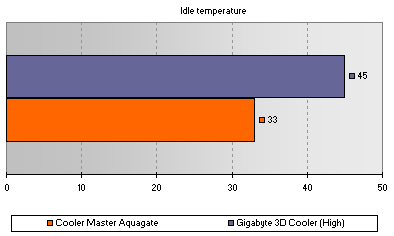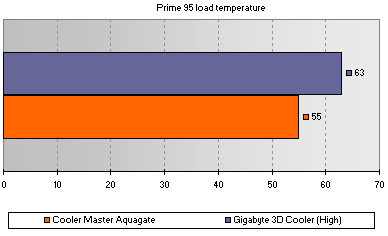System setup and results
To test the Aquagate, I've set it up against a high-end air cooling solution, in the form of Gigabyte's 3D Cooler Ultra GT, taking a look at it from both a temperature testing and noise point of view. You can see the system used below.
Hardware
EpoX EP-9NDA3+ motherboardAMD Athlon FX-53 (2.4GHz, 1MB L2, dual-channel memory), Socket 939
ATI Radeon X800 XT, AGP 8x, 256MB
1GB (2 x 512MB) Corsair DDR-I PC-3200 - 2-2-2-6
1 x 36.6GB Western Digital Raptor SATA
Cooler Master Aquagate
Gigabyte 3D Cooler Ultra GT
Software
Windows XP Professional w/ SP2
nForce drivers v5.10
DirectX 9.0c End User Runtime
Prime 95
Temperature Testing
To take a look at the performance of this solution against the competition, let's start by taking a quick look at how it handles the heat of an FX-53 under idle conditions.

The superiority of a water cooling solution is immediately evident here - Even with the 3D Cooler running with its fan at full pelt, the Aquagate still comes in over 10 degrees cooler. Of course, you aren't going to buy a rig just to have it sit there and do nothing, you'll be wanting to give a workout. So, we've stress tested the two solutions by using a 30 minute run of Prime 95s 'In-place large FFTs' torture test, designed to stress the CPU in a manner which will generate large amounts of heat. We then measured the CPU temperature results using Motherboard Monitor. Below, you can see the maximum temperature the CPU had reached at the end of the thirty minute period.

You can see a large rise in temperature under both solutions with such a stressful test running, but the Aquagate still stands head and shoulders over its rival, to the tune of keeping the system eight degrees cooler. There was quite some discrepancy between the results shown by Motherboard Monitor and the Aquagate's own thermal monitor, but as this is highly dependant on the placement of the thermal sensor on the CPU or water block, this is to be expected.
Noise
The Aquagate's main LCU allows for three different fan settings, which can be selected via the controls on the LCD panel. We showed the noise rating of the Aquagate earlier in the article, stated as 24/44/49 dB on the packaging, and it has to be said that at its highest setting, it is loud. Very loud, more so than the 3D Cooler running at full tilt. The unit is also still somewhat noisy on its medium fan setting, with only the lowest setting giving a far quieter mode of operation. There is a slightly irritating whine that comes with the fan spinning, even at its lowest setting, which may be off-putting. This is certainly something to consider if you're worried about excessive noise, and is a little disappointing considering that one of the benefits of such a setup is usually its quiet operation. Of course, this does depend to some extend on where you install the unit, as fitting it internally will most likely muffle some of the noise the unit generates, particular the aforementioned whine at its low fan speed setting.









